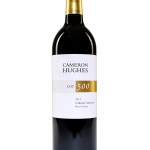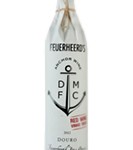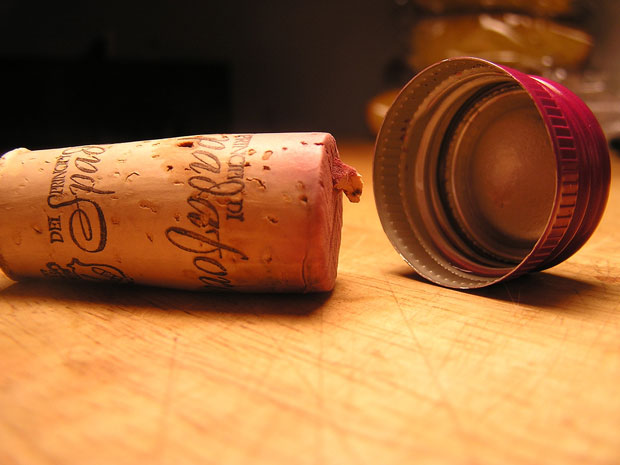Greetings and salutations! The first time I ordered a “real” bottle of wine at a decent restaurant I experienced a truly awkward moment when my waiter (no sommelier, the restaurant wasn’t THAT decent) presented the cork to me for inspection. The pressure was on, and the time was short. My significant other was intently watching me to evaluate my command of the scene. My palms began to sweat. What in the wide world of sports was I to do with the silly, stained stopper? Look at it? Sniff it? Ignore it? Give it a polite round of applause? I have since gathered that most wine lovers simply give the cork a quick view to make sure the cork has not been compromised and is somewhat moist, thus indicating that it did its intended job. However, the seared memory of my uncomfortable dilemma eventually evolved to the topic of this month’s musings: why is a cork even needed?
In a nutshell, a cork is a form of a bung made of real cork, artificial cork or even hard rubber designed to seal a wine bottle and keep the destructive air away from the precious wine. Its usefulness becomes painfully obvious to those who have accidently left a partially-consumed bottle uncorked overnight and discovered expensive wine vinegar the next day. Or so I’ve heard from a “friend”…of course, that experience that has never happened to me.
For years many “cheap” bottles of wine came with an alternative stopper commonly known as a screw cap, which have long been the source of humor and disparagement from even casual wine snobs. [Insert your favorite wino/fortified wine joke here.] In all sincerity, there were times before I had mastered the skill of corking a bottle of wine that I was grateful to have the simplicity of the screw cap to avoid social disasters. Later, as I became reasonably proficient at using the necessary tools without being banned from polite society, I joined the long parade of wine lovers who looked down their noses at screw caps. Surely no “real” wines would ever be offered in bottles with a screw cap. How positively gauche!
Then as I became acquainted with the good shiraz and other big reds offered by Australian vineyards I got a jolt of reality when I noticed that many fine Aussie wines were delivered by bottles sealed with screw caps. What? How could this be? Perhaps those crazy Australian winemakers didn’t have access to good cork at a reasonable price, or maybe they just were dedicated to acting as contrarians. Who knows–after all, these folks consider Vegemite a delicacy! I ultimately concluded that the use of screw caps didn’t appear to be a quality determination in the wines, but rather a preference from Aussie winery to winery.
Well, I thought to myself, no way that any stellar vineyards in the heart of Napa Valley will ever take that cavalier approach to bottling their prized cabernet sauvignons and chardonnays. Give me cork, or give me death! I was quite proud of my assumption, knowing that order was restored in these United States, as well as most of the civilized world. And then about five years ago I visited the PlumpJack winery in the heart of Oakville, Napa Valley, ground zero for phenomenal cabs.
During a tasting at PlumpJack, I discovered much to my dismay that I could purchase some of the finest, most expensive reserve offerings of PlumpJack (as well as CADE, its sister winery) in either corked bottles or (gasp!) screw cap bottles. Robert Parker evidently loved both versions based upon his very impressive ratings of PlumpJack wines, so the choice of seal was totally up to me. I was also told that PlumpJack’s stellar winemakers didn’t prefer one version over the other, even for long term storage. This apparent blasphemy from a vineyard that literally has a cork tree within paces of the PlumpJack tasting room? Oh, well, back to the drawing board for my cork theory!
Time will tell whether other quality Napa Valley vineyards follow suit with PlumpJack’s and CADE’s lead here, but at bare minimum I think it is fair to conclude that the centuries-old assumption that real cork is the only proper form of stopper for fine wine is up for reasonable debate. As for me, at least for now I’m going to stick with the old school cork, but then I still stubbornly insist on shifting my own gears in my car rather than settling for an automatic transmission, so what do I know?
This ends my diatribe, so let’s get on to this month’s wine recommendations.
Value Wine No. 1: The Napa Everyday Cabernet Sav.
There’s a better than zero chance that I may have mentioned my affinity for cabernet sauvignon wines in earlier installments of The Wine Bargain Sleuth. To prove that I am serious, my first Value Wine for this month is the Avalon Napa Valley cabernet sauvignon (2009). This amazing wine is widely available for $16 or perhaps better if you shop carefully. This is a balanced, extremely well-made cabernet sav that has been remarkably consistent over the past several vintages. It is a medium bodied cabernet but one that has a surprising amount of complexity and a rewarding, smooth finish. Despite its bargain price, Avalon claims to deliver 100% Napa Valley fruit, which is quite believable given the quality of this wine. Robert Parker expressed his admiration for the 2009 Avalon offering thusly: “Avalon’s wines are well-worth seeking out given their amazingly low prices.” Parker awarded a very solid 88 to this 2009 vintage. If you are just getting to know the wonders of Napa Valley cabernet sauvignons, I highly recommend the 2009 Avalon as a very attainable benchmark. Without a doubt there are higher-rated, bigger and better tasting cabs in Napa, but a quick check of the average prices of these wines confirm that Avalon is well worth your time to track down and bring home! This is a perfect wine to serve to discerning weekend guests and to enjoy during the week. The 2009 Avalon would make a good pairing with grilled pork or barbeque as well as hearty pasta dishes with red sauces, yet is light enough to be served without food. You can set this wine down for a few years or drink it now.
Value Wine No. 2: A Bargain from Tuscany, Italy.
My second Value Wine for March is the Monte Antico Toscana (2007), an Italian “Super Tuscan” blend of 10% cabernet sauvignon, 5% merlot and the balance of the more traditional Tuscan grape sangiovese. This smooth-drinking Italian is sure to please a discriminating wine drinker, and best of all for the wine cork challenged, it comes sealed with a screw cap. I love it when a theme comes together! This is a house favorite for pizza, savory pasta dishes and even grilled burgers or sausages. You can find it almost anywhere for $13 or less, and the past 2 vintages have gathered 90 ratings from the likes of James Suckling and Wine Spectator. This great Italian is widely available, and I have seen it priced as low as $9 with diligent shopping. Buy and enjoy it—the 2007 Monte Antico is drinking beautifully right now. I hope that the fine winemakers at Monte Antico can keep up the good work at this price point. This is a great example of a bargain wine that you will be proud to serve.
Worth a Splurge Wine of the Month: A Touch of Rutherford Dust.
Okay, this month’s Chapter is all about great red wines. I like reds. So sue me. This month’s Splurge Wine is a long-time favorite and a beautiful example of what the lovers of the Rutherford appellation of Napa Valley call the “Rutherford Dust”: the 2006 Peju Napa Cabernet Sauvignon. Peju is a small, family-owned vineyard that happens to be located on some serious cabernet real estate on the floor of Napa Valley. Although not widely distributed due primarily to a very loyal wine club following, Peju is beginning to market more aggressively; in fact, I recently saw a prominent display of their amazing red wines at a store in San Francisco International Airport. Wine Enthusiast magazine laid a strong 93 rating on this wine, describing it thusly: “If hedonism is what you like in a cab, you’ll love this lush bottling from Peju…outstanding.” If your local wine merchant doesn’t carry Peju, then you can find the great wines at www.peju.com. Trust me, you’ll be glad you did, and this wine is easily worth its $45 retail price. This is a Napa Big Boy.
Thought for the Day: Fun With Oxygen.
If you are serving a big, young red wine to your guests and you don’t have time to properly decant the bottle, a good alternative is to use science to force oxygen into the wine as you pour it. There are many cool products available to assist you with “turbocharging” your wine, but my personal favorite is the Vinturi, a self-described “essential wine aerator.” You simply pour the wine from the bottle through the Vinturi, and seconds later you have a great glass of wine. It’s not only a fun bar trick, but I love the sucking sound of air being forced into the wine. Try undecanted wine with and without the Vinturi. I believe you can taste the difference. The Vinturi is widely available for about $40. Cheers!
© The Wine Bargain Sleuth 2012—All Rights Reserved









Testimonials
Len Musgrove
"Brad, Happy New Year to you, Nicole and the kids! I ..."
Brad Bell
"Thanks Len. I will be checking out a few of your suggestions. Wishing ..."
Vince Papali
"Well done! Eagles still have a chance! See you soon! "